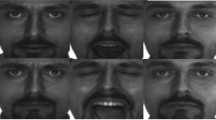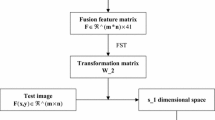Abstract
A novel combined personalized feature framework is proposed for face recognition (FR). In the framework, the proposed linear discriminant analysis (LDA) makes use of the null space of the within-class scatter matrix effectively, and Global feature vectors (PCA-transformed) and local feature vectors (Gabor wavelet-transformed) are integrated by complex vectors as input feature of improved LDA. The proposed method is compared to other commonly used FR methods on two face databases (ORL and UMIST). Results demonstrated that the performance of the proposed method is superior to that of traditional FR approaches
Similar content being viewed by others
References
Belhumeur, P.N., Hespanha, J.P., Kriegman, D.J.. 1997. Eigenfaces vs. Fisherfaces: Recognition using class specific linear projection,IEEE Trans Pattern Anal Machine Intel,19(7):711–720.
Bruce, V., Hancock, P., Burton, M., 1998. Human Face Perception and Identification, Face Recognition: From Theory to Application. NATO ASI Series, p. 51–72.
Burr, D., Morrone, M., Spinell, D., 1989. Evidence for edge and bar detectors in human vision.Vision Research,29(4):419–431.
Chen, L.F., Liao, H.Y., Mark, K.M.T., Lin, J.C., Yu, G.J., 2000. A new LDA-based face recognition system which can solve the small sample size problem.Pattern Recognition,33(10):1713–1726.
Dassigi, V., Mann, R.C., Protopoescu, V.A., 2001. Information fusion for text classification-an experimental comparison.Pattern Recognition,34(12):2413–2425.
Daugman, J., 1988. Complete discrete 2-D Gabor transform by Neural networks for image analysis and compression.IEEE Trans on Acoustics, Speech, and Signal Processing,36(7):1169–1179.
Golub, G.H., van Loan, C.F., 1996. Matrix Computations, Third Ed. The Johns Hopkins University Press, Baltimore, p. 35–37.
Graham, D.B., Allinson, N.M., 1998. Characterizing virtual eigensignatures for general purpose face recognition.Face Recognition: From Theory to Applications, NATO ASI Series F. Computer and Systems Sciences,163:446–456.
He, C., Zheng, Y.F., Ahalt, S.C., 2002. Object tracking using the Gabor wavelet transform and the golden section algorithm.IEEE Trans on Multimedia,4(4):528–538.
Kalocsai, P., Malsburg, C., Horn, J., 2000. Face recognition by statistical analysis of feature detectors.Image and Vision Computing,18:273–281.
Li, H.Y., Deklerck, R., Cuyper, B.D., Hermanus, A., Nyssen, E., Cornelis, J., Hermanus, A., Nyssen, E., Cornelis, J., 1995. Object recognition in brain CT-scans: knowledge-based fusion of data from multiple feature extractors.IEEE Trans on Medical Imaging,14(2):212–228.
Liu, C.J., Wechsler, H., 2001. A shape- and texture-based enhanced fisher classifier for face recognition,IEEE Trans. on Imaging Processing,10(4):598–608.
Liu, C.J., Wechsler, H., 2002. Gabor feature based classification using the enhanced fisher liner discriminant model for face recognition.IEEE Trans on Image Processing,11(4):467–475.
Lu, J.W., Plataniotis, K.N., Venetsanopoulos, A.N., 2003a. Face recognition using LDA-based algorithms.IEEE Trans on Neural Networks,14(1):195–200.
Lu, X.G., Wang, Y.H., Jain, A., 2003b. Combining classifiers for face recognition.Inter Conf Multimedia and Expo.3:6–9.
Luo, J.H., 1992. Introduction to Matrix Analysis. South China University of Technology Press, Guangzhou, p. 53–69 (in Chinese).
Nastar, C., Mitschke, M., 1998. Real-time Face Recognition Using Feature Combination. IEEE Inter Conf on Automatic Face and Gesture Recognition, p. 312–319.
ORL face database, 1994. AT&T Laboratories, Cambridge, U.K. Available: http://www.uk.research.att.com:pub/data/att_faces.zip.
Peli, T., Young, M., Knox, R., Ellis, K.K., Bennett, F., 1999. Feature level sensor fusion, proceedings of the SPIE sensor fusion: Architectures.Algorithms and Applications III,3719:332–339.
Swets, D., Weng, J., 1996. Using discriminant eigenfeatures for image retrieval.IEEE Trans on pattern Analysis and Machine Intelligence,18(8):831–836.
Turk, M., Pentland, A., 1991. Eigenfaces for recognition,J. Cognitive Neurosci,3(1):71–86.
Yang, J., Yang, J.Y., Zhang, D., Lu, J.F., 2003. Feature fusion: parallel strategy vs. serial strategy,Pattern recognition.36(6):1369–1381.
Yu, H., Yang, J., 2001. A direct LDA algorithm for high-dimensional data with application to face recognition.Pattern Recognition,34(10):2067–2070.
Yu, B., Jin, L.F., Chen, P., 2003. A new LDA-based method for face recognition.Journal of Computer-Aided Design & Computer Graphics,15(3):302–306.
Zhao, W.Y., Chellappa, R., Rosenfeld, A., Phillips, P.J., 2000. Face Recognition: A Literature Survey. UMD CFAR Technical Report CAR-TR-948.
Author information
Authors and Affiliations
Additional information
Project (No. 60275023) supported by the National Natural Science Foundation of China.
Rights and permissions
About this article
Cite this article
Wen-shu, L., Chang-le, Z. & Jia-tuo, X. A novel face recognition method with feature combination. J. Zheijang Univ.-Sci. A 6, 454–459 (2005). https://doi.org/10.1631/jzus.2005.A0454
Received:
Revised:
Published:
Issue Date:
DOI: https://doi.org/10.1631/jzus.2005.A0454
Key words
- Fisher discriminant criterion
- Face recognition (FR)
- Linear discriminant analysis (LDA)
- Principal component analysis (PCA)
- Small sample size (SSS)




